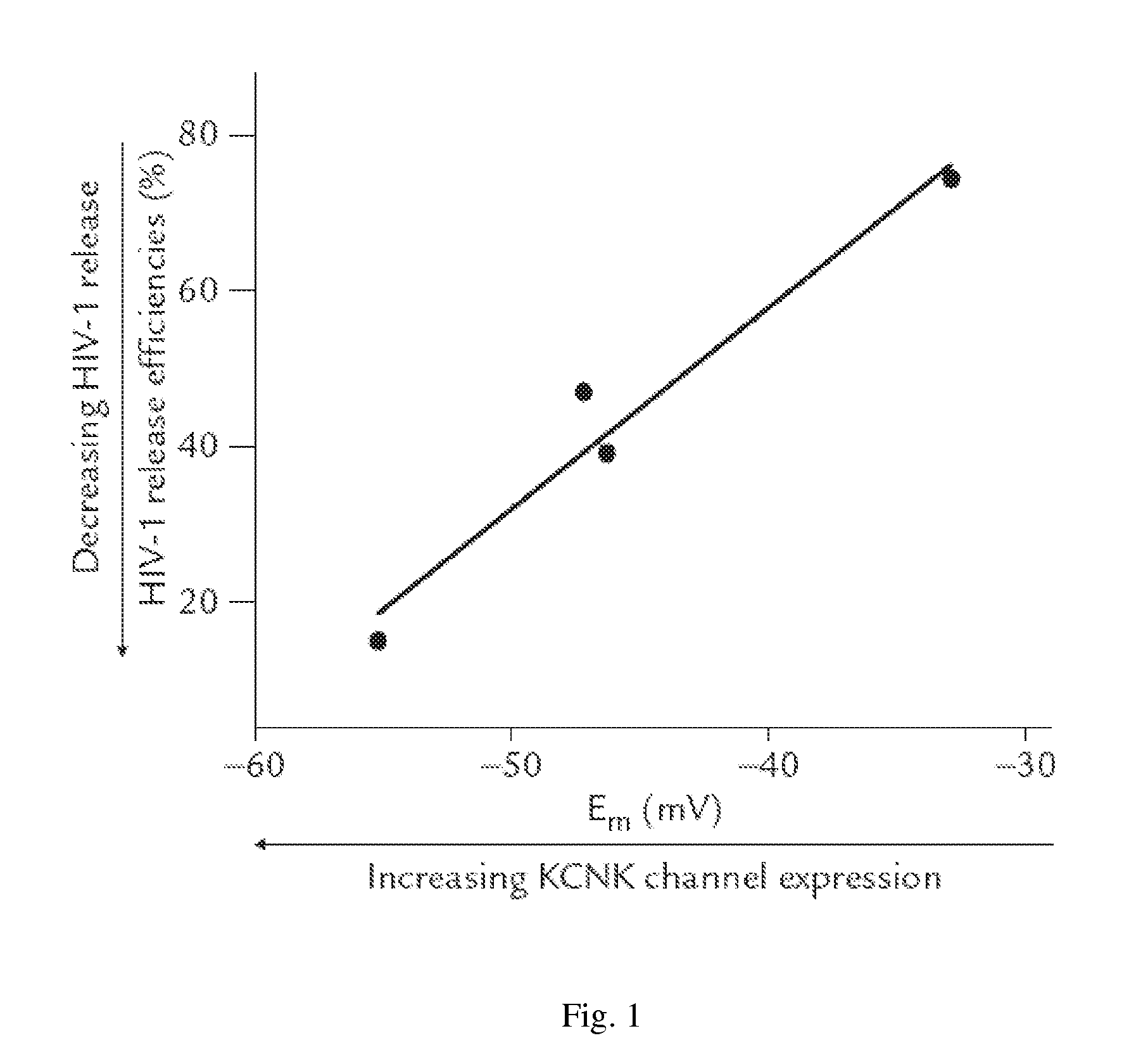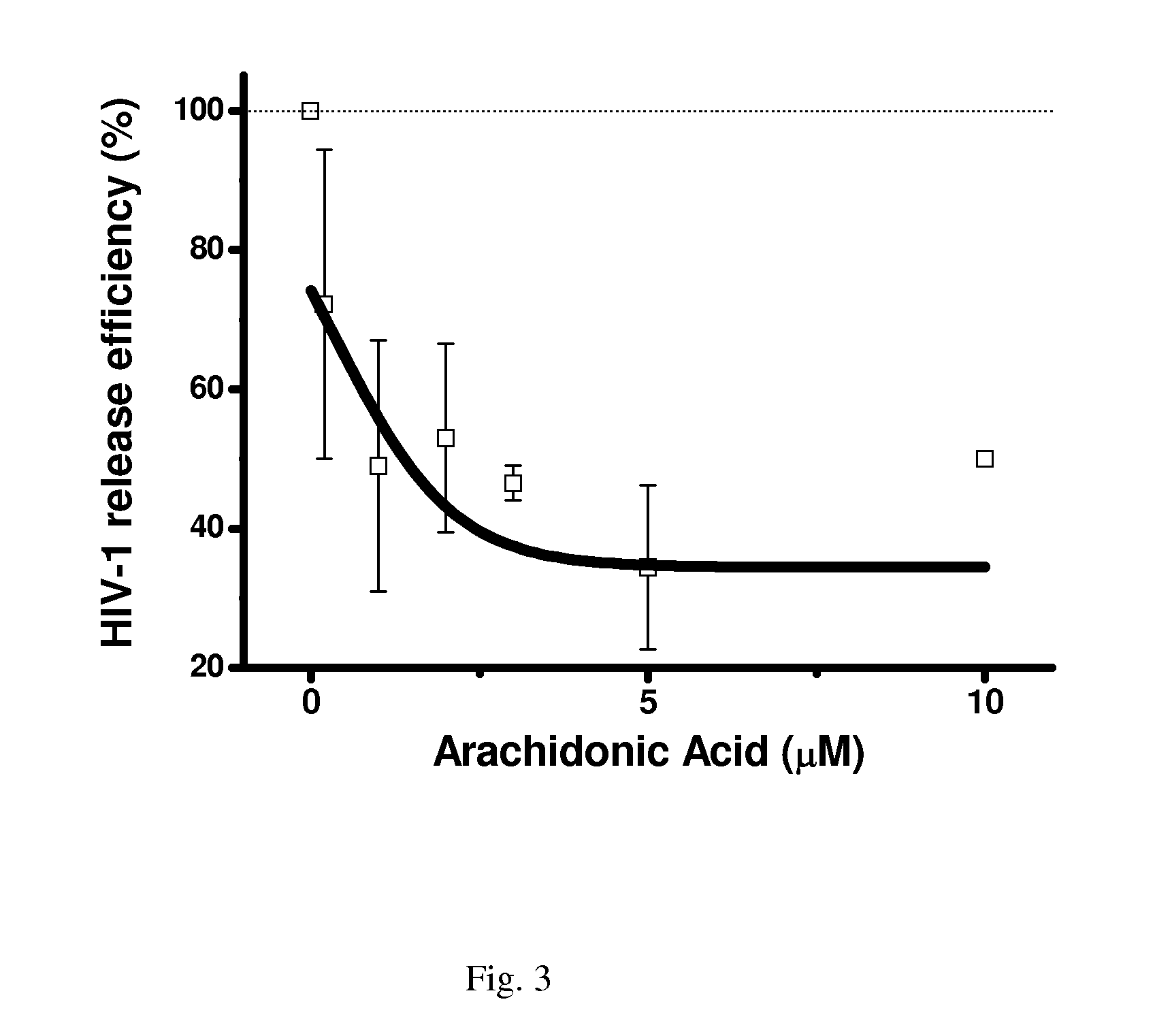Supplement for reducing HIV transmission and method thereof
a technology of hiv and supply, applied in the field of supply, can solve the problems of unavoidable breastfeeding by hiv-positive mothers, inability to replace breast feeding in pandemic, and inability to improve low-income countries, so as to drive membrane potential hyperpolarization and suppress harmful excitability or secretion.
- Summary
- Abstract
- Description
- Claims
- Application Information
AI Technical Summary
Benefits of technology
Problems solved by technology
Method used
Image
Examples
example 1
HIV-1 Particle Release and Membrane Potential Depolarization
[0034]FIG. 1 shows the relationship between HIV-1 particle release and membrane potential depolarization. Each dot represents an averaged value for the dual effects of KCNK3 or one of its functionally distinct mutants on membrane potentials (x-axis) and on HIV-1 particle release efficiency (y-axis). Cell membrane potentials (Em) in a Ringer-like solution were determined by whole-cell patch-clamp recordings. HIV-1 particle release was determined by quantifying the concentration of HIV structural protein p24 using ELISA, which gives the number of secreted viral particles. The inhibitory effects of KCNK3 and its channel mutants on viral release were compared with the single expression of HIV-1 (set at 100%) in HeLa cells.
[0035]The cell membrane potentials could be maintained at about −40 mV to −50 mV when HIV-1 and KCNK3 channels were co-expressed heterologously in cervical cancer HeLa cells, and the HIV-1 particle release was...
example 2
The Effects of a Mixture of Docosahexaenoic Acid (DHA) and Arachidonic Acid (AA) on Membrane Potential Polarization
[0040]Referring to FIG. 2, the inhibitory effect of arachidonic acid (AA) and docosahexaenoic acid (DHA) on the channel activity of KCNK3 and KCNK9 (KCNK3 / 9) in HeLa cells was shown.
[0041]To mimic the depolarized state of HIV-infected cells, endogenous KCNK3 and KCNK9 channels (KCNK3 / 9) in HIV-1-susceptible cells (i.e. human CD4+ T cells; HeLa cells) were partially knocked down using a low dose of the specific small interfering RNA (siRNA). DHA and AA, each at a concentration equivalent to the recommended dietary intake (1-3.6 μM in cell culture), were supplemented in the form of an arachidonic acid (AA)-docosahexaenoic acid (DHA) mixture with a 2:1 ratio (w / w). The AA-DHA mixture was found to restore the activities of endogenous KCNK channels that were partially knocked down. The activity of endogenous KCNK channels was assessed in terms of cell membrane potential at v...
example 3
The Effects of Arachidonic Acid (AA) Alone on HIV-1 Viral Release
[0048]HeLa cells at 50% confluency in P25 flasks were transiently transfected with 2-3 μg of one of the HIV-1 proviral constructs (pNL4-3; pNL4-3 / Udel). One-tenth of the culture media was retrieved from each sample and filtered through a 0.22-μm syringe filter at each time point. Cells were collected at the end and subjected to whole-cell lysis by 1% SDS. The viral content in culture media and in cell lysates was determined by Coulter HIV-1 p24 Antigen Assay kit. Virus release was compared to that from the control (co-transfection of pNL4-3 and pCGI). Data are expressed as mean±SEM from 8 independent experiments.
[0049]For the inhibitory effects of K2P channel, different quantities (0.02-10 μM) of arachidonic acid (Sigma) were tested in HeLa cell culture at the 24th hour post-transfection of NL4-3, and one-tenth of the media was retrieved and filtered at each time point. Viral release was compared to that of the untreat...
PUM
| Property | Measurement | Unit |
|---|---|---|
| membrane potential | aaaaa | aaaaa |
| cell membrane potentials | aaaaa | aaaaa |
| concentration | aaaaa | aaaaa |
Abstract
Description
Claims
Application Information
 Login to View More
Login to View More - R&D
- Intellectual Property
- Life Sciences
- Materials
- Tech Scout
- Unparalleled Data Quality
- Higher Quality Content
- 60% Fewer Hallucinations
Browse by: Latest US Patents, China's latest patents, Technical Efficacy Thesaurus, Application Domain, Technology Topic, Popular Technical Reports.
© 2025 PatSnap. All rights reserved.Legal|Privacy policy|Modern Slavery Act Transparency Statement|Sitemap|About US| Contact US: help@patsnap.com



